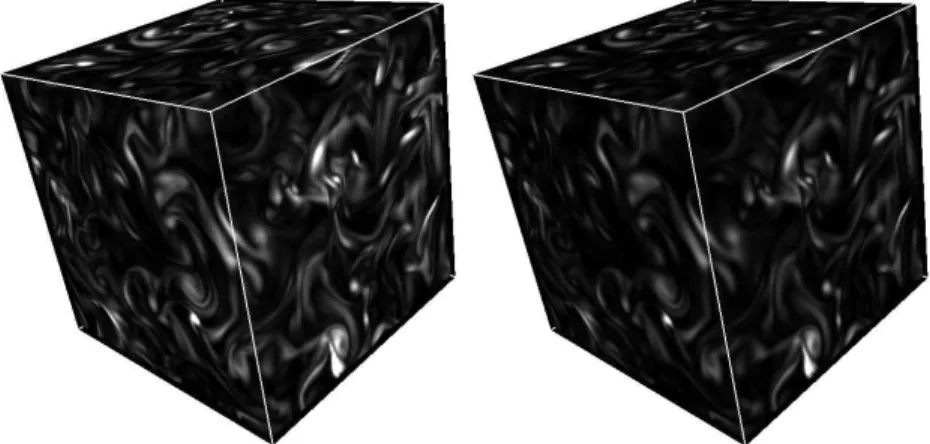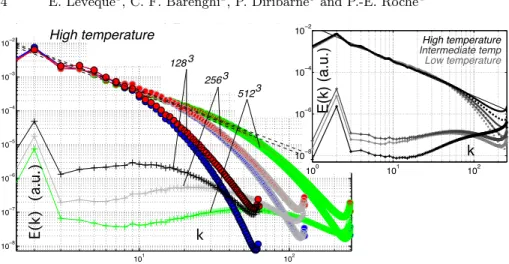HAL Id: hal-00430190
https://hal.archives-ouvertes.fr/hal-00430190
Submitted on 12 Aug 2010
HAL is a multi-disciplinary open access
archive for the deposit and dissemination of
sci-entific research documents, whether they are
pub-lished or not. The documents may come from
teaching and research institutions in France or
abroad, or from public or private research centers.
L’archive ouverte pluridisciplinaire HAL, est
destinée au dépôt et à la diffusion de documents
scientifiques de niveau recherche, publiés ou non,
émanant des établissements d’enseignement et de
recherche français ou étrangers, des laboratoires
publics ou privés.
Turbulent cascade of a quantum fluid at finite
temperature
Emmanuel Lévêque, Carlo Barenghi, Pantxo Diribarne, Philippe-Emmanuel
Roche
To cite this version:
Emmanuel Lévêque, Carlo Barenghi, Pantxo Diribarne, Philippe-Emmanuel Roche. Turbulent cascade
of a quantum fluid at finite temperature. 12th EUROMECH European Turbulence Conference, Sep
2009, Marburg, Germany. pp.281-284, �10.1007/978-3-642-03085-7_68�. �hal-00430190�
Turbulent cascade of a quantum fluid at finite
temperature
E. L´evˆeque1
, C. F. Barenghi2
, P. Diribarne3
and P.-E. Roche4
(1) Laboratoire de Physique, ENS Lyon, CNRS / Universit´e de Lyon, F-69364 Lyon, France
(2) School of Mathematics and Statistics, Newcastle University, Newcastle upon Tyne NE1 7RU, UK
(3) SBT, INAC CEA/ UJF, 38054 Grenoble cedex 9, France
(4) Institut N´eel, CNRS / UJF, BP 166, F-38042 Grenoble cedex 9, France philippe.roche at grenoble.cnrs.fr
1 Introduction : Motivation and Model
Quantum fluids (liquid3
He and4
He, atomic Bose-Einstein condensates) con-sist of two co-penetrating fluids: the superfluid, associated to the quantum ground state, and the normal fluid, associated to thermal excitations. In this work the turbulent inertial cascade undergone by a quantum fluid at small but finite temperature above absolute zero is simulated by DNS of two cou-pled Navier-Stokes equations[1]. Following the two-fluid model of Landau and Tisza, one equation accounts for the viscous normal fluid, while the other equation models superfluid dynamics on scales larger than the inter-vortex spacing.
The originality of our approach consists in introducing an artificial su-perfluid viscosity - as a turbulence closure - to model non-viscous processes taking place on scales smaller than the inter-vortex spacing, such as phonon emission. For simplicity, the fluids’ coupling -often called “mutual friction”-is a simplified version of the coupling of the HVBK model[1]. With obvious notation, the governing equations of the two fluids are :
Dvs Dt = − 1 ρs∇ps+ νs∇ 2 vs−ρ n ρ B 2|ωs|(vn− vs) Dvn Dt = − 1 ρn∇pn+ νn∇ 2 vn+ρρsB2|ωs|(vn− vs)
where the subscripts “n” and “s” stand for “normal fluid” and “superfluid”, ωs is the superfluid vorticity, B = 2 and the velocity fields are solenoidal. This model allows us to take advantage of optimized parallelized codes in exploring the interaction between the two fluids. This paper is more focused on numerical aspects, the physical interpretation will be discussed elsewhere.
2 E. L´evˆeque1
, C. F. Barenghi2
, P. Diribarne3
and P.-E. Roche4
2 Numerical aspects
Numerical simulations refer to the integration of the previous dynamical equa-tions in a cubic domain with periodic boundary condiequa-tions in the three direc-tions. The simulations rely on a parallel (distributed-memory) pseudo-spectral solver[2]. Three grid sizes are considered, 1283
, 2563
and 5123
respectively. The velocity Fourier modes are advanced in time by a second-order Adams-Bashforth scheme.
The ratio between the density of the normal fluid and the density of the superfluid is ρn/ρs = 0.1, 1 or 10 respectively for “low”, “intermediate” and
“high” temperatures. The ratio between the kinematic viscosities is fixed at νn/νs= 4, which is a compromise chosen to separate the dissipative cut-off
wavenumbers of the two fluids and maximize the extension of the inertial range of the superfluid.
In order to ensure (statistical) stationarity, a constant-energy flux is sup-plied to the Fourier modes in the shell of wave-vectors 1.5 < |k| < 2.5. This external energy flux applies to the normal fluid in the high-temperature and intermediate-temperature cases, and to the superfluid in the low-temperature case. This forcing scheme permits a rapid relaxation to a steady state, which is attained when the total dissipation fluctuates around the imposed energy input flux.
The transient from the initial state is monitored by the space–averaged enstrophies < ω2
n>, < ω 2
s> and < (ωs− ωn)2>. The first three subplots of
Fig. 1 show this transient.
3 Results
The fourth subplot of Fig. 1 shows that correlation between ω2 s and ω
2 n is
larger than 97% in steady state, indicating a strong locking of the two fluids. Fig. 2 illustrates this locking in physical space : the vorticity structures -slightly more intense in the superfluid - are indeed overlapping. A similar conclusion was reached recently in a numerical simulation performed at high temperature without coupling from the superfluid to the normal fluid [3].
Fig. 3 shows velocity power density spectra under various conditions; for both fluids there is clear evidence of an inertial range compatible with a -5/3 Kolmogorov-like scaling. This figure also shows the power spectra of the slip velocity vs− vn. We find that this quantity peaks at small scales, where νn
efficiently damps the kinematic energy of the normal fluid. The spectra in the inset are obtained at different temperatures but with fixed νs, νn and
total injected energy. They show that the extend of the inertial range varies with temperature, showing that the Reynolds number - defined using the separation of large and small scales - is a temperature dependent parameter in our two-fluid system.
Turbulent cascade of a quantum fluid at finite temperature 3 0 10 20 30 40 50 60 70 80 90 100 0 5 10 15 20 25 time (s) En st ro p h y (N O T N O R MAL ISED ) Enstrophy Low temperature 0 10 20 30 40 50 60 70 80 90 !2 0 2 4 6 8 10 12 time (s) En st ro p h y (N O T N O R MAL ISED ) Enstrophy 0 10 20 30 40 50 60 70 80 90 !1 0 1 2 3 4 5 6 7 8 time (s) Enst rop hy (N O T N O R MALI SED ) Enstrophy High temperature Medium temperature Time (a.u.) Time (a.u.) Time (a.u.) T ot a l E n st roph y ( a .u .) T ot a l E n st roph y ( a .u .) T ot a l E n st roph y ( a .u .) 0 20 40 60 80 100 120 140 160 0.9 0.91 0.92 0.93 0.94 0.95 0.96 0.97 0.98 0.99 coeff corr time (s) Sa n s u n it e Time (a.u.) C or re la ti on
Normal / Superfluid enstrophy correlation
Fig. 1.Subplots 1,2 and 3 illustrate for different temperature the convergence to the steady state by monitoring the total enstrophy of the superfluid < ω2
s> (top curve),
normal fluid < ω2
n> (intermediate curve) and the slip enstrophy < (ωs−ωn) 2
> (lower curve). These simulations were performed with grid resolution 5123
. Subplot 4 shows the correlation between the superfluid and normal fluid enstrophy fields during the transient to the steady state. These simulations were performed with grid resolution 2563
and 5123
.
Fig. 2. Local enstrophy of the superfluid (left) and normal fluid (right) at high temperature (ρn/ρs = 10). Grid resolution is 256
3
. This visualisation is generated with “Vapor” freeware. (www.vapor.ucar.edu)
4 E. L´evˆeque1
, C. F. Barenghi2
, P. Diribarne3
and P.-E. Roche4
101 102 10!8 10!7 10!6 10!5 10!4 10!3 10!2 k
normal fld ( !n/s= 10/1 , k"n/s= 1/0 , k#n/s= 0.3/0.075 ) run256 HIGH run003
superfluid ( ! n/s= 10/1 , k"n/s= 1/0 , k#n/s= 0.3/0.075 ) run256!HIGH!run003 difference ( !n/s= 10/1 , k"n/s= 1/0 , k#n/s= 0.3/0.075 ) run256!HIGH!run003 !5/3 normal fld ( ! n/s= 10/1 , k"n/s= 1/0 , k#n/s= 1/0.25 ) run20!run001 superfluid ( !n/s= 10/1 , k"n/s= 1/0 , k#n/s= 1/0.25 ) run20!run001 difference ( ! n/s= 10/1 , k"n/s= 1/0 , k#n/s= 1/0.25 ) run20!run001 !5/3 k E (k ) ( a .u .) 512 128 256 3 3 3 100 101 102 10!8 10!6 10!4 10!2 k E(k) (a .u
.) Intermediate temp!High temperature!
Low temperature High temperature
Fig. 3. Velocity spectra at high temperature for resolutions 1283
, 2563
and 5123
. For each resolution, and from top to bottom : superfluid, normal fluid and slip velocities vn, vsand vs− vn. Dashed line : -5/3 scaling. Inset : Velocity spectra for
fixed kinematic viscosities and total energy injection, at high (black), intermediate (jackson) and low (gray) temperatures. Continuous line : -5/3 scaling.
4 Conclusion
The locking between the superfluid and the normal fluid which we observe, as well as the Kolmogorov scaling, are consistent with the present theoretical understanding of quantum turbulence[4]. This work extends the numerical ev-idence over a wide temperature range, using a self-consistent coupling model between the two fluids. Two new features which we observe are the peaking of the slip velocity at small scales, and the temperature dependence of the Reynolds numbers for fixed energy injection and kinematic viscosities.
Acknowledgements : We thank L. Chevillard and J. Salort for useful
discussions and support. CPU resources were provided by local computing facilities (PSMN at Ens-Lyon) and french supercomputing centers (CINES and CCRT-CEA). Supports from EPSRC (EP/D040892) and ANR TSF are acknowledged.
References
1. Quantized vortices in Helium II. Donnelly, R.J., Cambridge University Press(1991)
2. Leveque E. and Koudella C., Phys. Rev. Lett. 86, 4033 (2001)
3. Morris, K., Koplik, J., and Rouson, D.W.I. Phys. Rev. Lett. 101, 015301 (2008) 4. Vinen W. F., and Niemela J. J J. Low Temp. Phys. 128 , 167 (2002)

